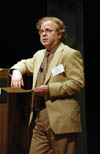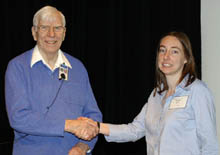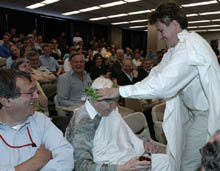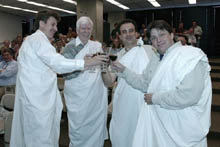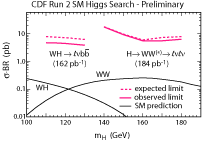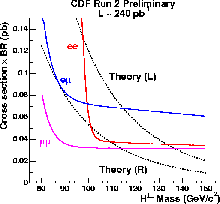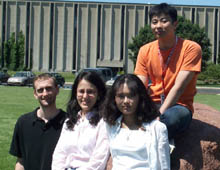 | Thursday, June 3, 2004 |
|
Thursday, June 3 9:00 a.m. Users' Annual Meeting - Auditorium THERE WILL BE NO THEORETICAL PHYSICS SEMINAR THIS WEEK THERE WILL BE NO DIRECTOR'S COFFEE BREAK TODAY THERE WILL BE NO ACCELERATOR PHYSICS AND TECHNOLOGY SEMINAR TODAY 5:00 p.m. Graduate Student Association New Perspectives Poster Session - Wilson Hall Atrium
Friday, June 4 |
|
Thursday, June 3 Minnesota Wild Rice Soup with Chicken Tuna Melt on Nine Grain $4.75 SW Skillet Steaks $4.75 Jumbo Stuffed Baked Potatoes $2.75 BLT Ranch Wrap $4.75 Cheesey Breadsticks $1.85 Toasted Pecan Chicken Salad $4.75 Wilson Hall Cafe Menu Chez Leon |
|
Extended Forecast |
Secon Level 3 |
| Fermilab Today is online at: http://www.fnal.gov/today/ Send comments and suggestions to today@fnal.gov Fermilab Today archive Fermilab Today PDF Version Fermilab Today classifieds Subscribe/Unsubscribe to |
|
From DC, Users Hear Call For Vision and Prioritization
"There hasn't been a rush to prioritize in this field, because we don't know what's going to pay off," Staffin said Wednesday morning in Ramsey Auditorium, as the Users Annual Meeting began its first day. "But that puts stresses on the financing. DOE and NSF need to make their [budget] requests with prioritization…We need a clear and compelling vision." Michael Turner, National Science Foundation Assistant Director for Mathematical and Physical Sciences, reinforced the point with his own "view from Washington," listing the challenges faced by particle physics. Among them: a tight budget, a $500 billion national deficit, higher national priorities, and expensive science with long lead times. "Things will get more difficult before they get better," Turner warned. Same message, different topic: Irving Lerch, recently retired after 11 years as American Physical Society Director of International Affairs, described the state of visa delays and backlogs for entering the U.S. as offering "probably no reason for optimism." Lerch said the impact on the field included research delays, longer times for degree completions, and university classes left without instructors. He noted that in 2003, there were more than 200,000 foreign students in the U.S. in the fields of engineering, math and computing sciences, and the natural sciences. He described the visa situation as especially "choking" the Middle East, which has more than 34,000 students in the U.S. The abundance of science on the day's program offered more promising prospects. Presentations includes results at both CDF and DZero in Top, Electroweak, B, QCD and New Physics; the strong upward trend in Tevatron luminosity; and Fermilab efforts to increase Linear Collider research and efforts to host the next generation machine. Fermilab theorist Chris Hill summarized the view of the future: "In 10 years, the written laws of physics will be different than they are now."
Today's program begins with a report from Universities Research Association,
Inc., president Fred Bernthal, followed by the presentation of the URA Thesis
Award.
| ||
|
CDF Hunts for the Higgs | ||
| ||
|
The Higgs boson (H), considered to be the origin of mass, is
the last unobserved particle in the Standard Model of
Particle Physics, and is thus the most sought after. Three
groups at CDF have produced new results in the quest for the
Higgs.
If the Higgs has a mass less than ~140 GeV, as suggested by global fits to precision electroweak data, one of the crucial modes of discovery at the Tevatron is via WH production. With the W boson decaying to leptons and the Higgs decaying to two b quarks, a relatively clean experimental signature is obtained. For a Higgs with mass greater than ~140 GeV, single Higgs production with the decay H->WW->leptons offers an additional promising signature. Because of the low Higgs production rate, the challenge is to reduce the backgrounds, consisting predominantly of W plus jets, top quarks, and direct WW production. | ||
| ||
|
Beyond the Standard Model there are likely to be additional Higgs bosons with varying properties. One possibility is the existence of a doubly-charged Higgs, predicted by a model that also accounts for the small observed neutrino
No evidence of the Higgs boson has been observed in these searches. CDF has thus set 95% CL limits on the Standard Model Higgs production cross section, as well as the existence of the doubly-charged Higgs, both of which will be further improved as Run II continues. | ||
| ||
|
Result of the Week Archive
|
|
May 31 - June 2 - Operations established one store during this 48 hour period that combined with an existing store provided the experiments with approximately 43 hours and 45 minutes of luminosity. - An AP1 Lambertson power supply needed daily attention. - Pbar suffered from clock problem. - Linac troubled by rectifier with water leak.
View the current accelerator update |
|
From Mercury News, June 1, 2004 Revolution in understanding By Glennda Chui As research director at Stanford Linear Accelerator Center, Persis Drell revels in the big questions.
What is the universe made of? How did we get here, and where are we going? What is the nature of matter and energy, space and time?
|
|
2003 Top Cited HEP Articles Michael Peskin's review of the top cited HEP articles of 2003 has now been released. Look for Fermilab-authored papers at numbers 4, 26, 35, 65 and 67.
Fermi Singers Summer Concert |
